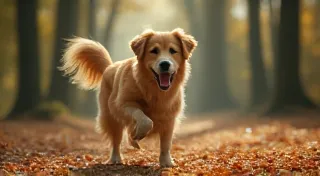Understanding Canine Body Language: Tail Wags and More
We all love watching our dogs, and it’s tempting to interpret their actions based on our own human emotions. However, dogs communicate through a complex system of body language, and misinterpreting their signals can lead to misunderstandings and even potentially dangerous situations. Learning to read canine body language is a crucial component of responsible pet ownership and effective dog training. It’s about so much more than just a wagging tail; it’s about understanding the nuanced messages they’re sending.
Beyond the Wag: It’s More Than Just a Happy Tail
The classic image of a dog wagging its tail is often associated with happiness. While a loose, broad wag *can* indicate friendliness, it’s important to understand that tail wags aren’t always positive. A tail wagging low or stiffly can signal anxiety or insecurity. The speed and direction of the wag also play a role. A fast, wide wag generally means excitement, while a slow, tentative wag can indicate uncertainty. A comprehensive understanding of these signals goes beyond simple observation; it involves recognizing the whole picture of canine communication, which is why many dog owners find resources like Understanding Dog Body Language: What Your Pup is Trying to Tell You incredibly helpful. Recognizing these signals is also vital when introducing your dog to new environments and other animals – it's all part of building a positive and well-adjusted pup!

Decoding the Eyes and Ears
A dog’s eyes are incredibly expressive. Soft, relaxed eyes often indicate contentment. However, staring, especially with a fixed gaze, can be a challenge or a threat. Dilated pupils (larger than normal) can indicate fear, excitement, or even pain. Observing these cues requires a keen eye and understanding of context. Early socialization plays a vital role in helping dogs, and their humans, understand each other. If you're welcoming a puppy into your home, exploring resources on The Ultimate Guide to Puppy Socialization: Setting Your Pup Up for Success can be a valuable first step. Socialization isn't just about introducing them to other dogs; it's about equipping them with the tools to confidently navigate a complex world, and understanding their body language is key to providing them with that support. A puppy’s ability to read the signals of others will set them up for success later in life.
Ear position is also a key indicator. Ears held erect and forward generally suggest alertness and interest. Ears pinned back against the head can indicate fear, submission, or anxiety. A relaxed, neutral ear position is common when a dog is comfortable.
Lip Cues and Facial Expressions
Pay close attention to a dog’s lips. A relaxed, open mouth is a sign of comfort. A tight-lipped expression can signal stress or tension. Panting, while often associated with heat, can also be a sign of anxiety. Showing teeth isn’t always aggression; sometimes it’s a submissive grin, a way of showing deference. Understanding the subtleties of these facial expressions helps build trust and strengthens the bond between you and your canine companion. Many times, a dog displaying signs of stress due to a confusing situation might benefit from a deeper dive into what socialization looks like for your pup - especially in unfamiliar environments.
Body Posture: A Full-Body Message
The overall posture of a dog communicates a great deal. A playful bow, with the front paws down and rear end in the air, is an invitation to play. A stiff, rigid posture can signal tension and a potential for aggression. A dog rolling over on its back, exposing its belly, is typically a sign of submission and trust (though not always – context matters!). Learning to interpret these cues takes practice, but it's a rewarding journey that deepens your connection with your dog. Different breeds, like the energetic and loyal Labrador Retriever, can display these signals in unique ways; understanding breed-specific behaviors is a valuable addition to your canine communication toolkit. For dogs who are struggling with anxiety, understanding these postures can lead to proactive interventions and a more fulfilling relationship.

The Importance of Breed-Specific Body Language
While the core principles of canine body language remain consistent across breeds, it’s important to remember that some breeds may express themselves differently. For example, a Greyhound might have a more subtle tail wag than a Golden Retriever. Furthermore, some breeds were originally bred for specific purposes, which can influence their communication style. A herding breed, for instance, may use a more assertive posture to guide other animals. Recognizing these subtle differences can significantly improve your understanding of your dog's communication.
Recognizing Displacement Behaviors
Dogs sometimes exhibit "displacement behaviors" when they're feeling conflicted or stressed. These are actions that seem out of context and serve to release tension. Common displacement behaviors include yawning (when not tired), lip licking, scratching, and shaking. Recognizing these behaviors is an important part of understanding what your dog is trying to tell you. They often indicate that your dog is feeling uncomfortable or overwhelmed and needs some space or reassurance. It’s often a sign they need a moment to process a complex environment.
The Role of Context: It’s Everything
Context is Key
It’s crucial to understand that dog body language should *always* be interpreted within context. A single behavior rarely tells the whole story. Consider the dog’s environment, its history, and its relationship with the people and animals around it. For example, a dog yawning might be a sign of tiredness, but it can also be a displacement behavior indicating stress. This holistic approach is vital for accurate interpretation and a deeper understanding of your dog's emotional state. Learning to decode this complex language is more than just observation; it's about developing a profound empathy for your canine companion. Understanding how a dog’s past experiences and their environment impact their communication is absolutely critical for proper interpretation.

How to Improve Your Observation Skills
Becoming proficient in reading canine body language takes time and practice. Here are some tips for improving your observation skills:
- Observe dogs in various situations: Pay attention to how dogs interact with each other and with people in different settings.
- Study dog body language resources: Books, articles, and videos can provide valuable insights.
- Take a dog behavior class: A qualified instructor can provide personalized feedback and guidance.
- Practice with your own dog: Pay close attention to your dog's body language in different situations and try to identify what they are trying to communicate.
- Consider breed-specific characteristics: Some breeds have more nuanced forms of communication, and learning about these can greatly enhance your understanding.
Beyond Bites: Building a Stronger Bond
Learning to understand canine body language isn't just about avoiding bites – it's about building a stronger bond with your dog and providing better pet care. By paying attention to these subtle cues, you can anticipate your dog’s needs, prevent behavioral problems, and create a more harmonious relationship. This knowledge is a valuable asset for all dog owners, and essential for effective dog training methods. Recognizing these signals, particularly during interactions with other animals, can lead to safer and more fulfilling experiences for everyone involved.
Decoding Complex Interactions: Dogs and Other Animals
Understanding canine body language is especially important when it comes to interactions with other animals. Dogs use a complex system of signals to communicate their intentions and boundaries. A stiff posture and direct stare can be a warning to back off, while a playful bow can be an invitation to engage. Paying attention to these signals can help prevent conflicts and promote harmonious relationships between dogs. The ability to interpret the subtle cues dogs exchange during playdates is a sign of a truly observant and empathetic owner.
The Ethical Considerations of Canine Communication
Responsible dog ownership includes respecting your dog’s ability to communicate. It is crucial to avoid misinterpreting signals and potentially causing them stress or discomfort. Always prioritize your dog’s wellbeing and allow them to express themselves without fear of punishment or misunderstanding. Being an informed and attentive owner leads to a happier, healthier, and more fulfilling relationship with your canine companion. Learning to "speak dog" is a continuous journey of observation, empathy, and mutual respect. Continuously refining your ability to understand your dog's subtle cues is a testament to your commitment to their well-being and a beautiful expression of the profound bond you share.





